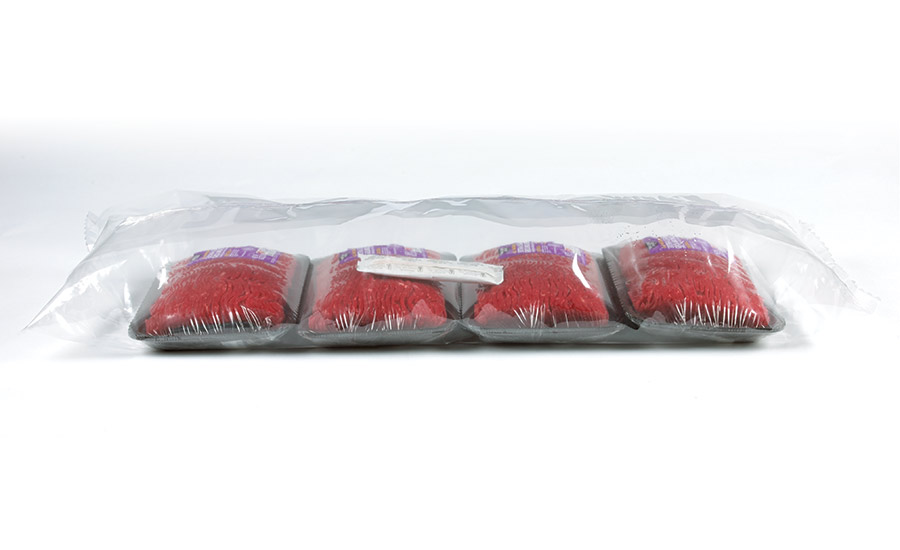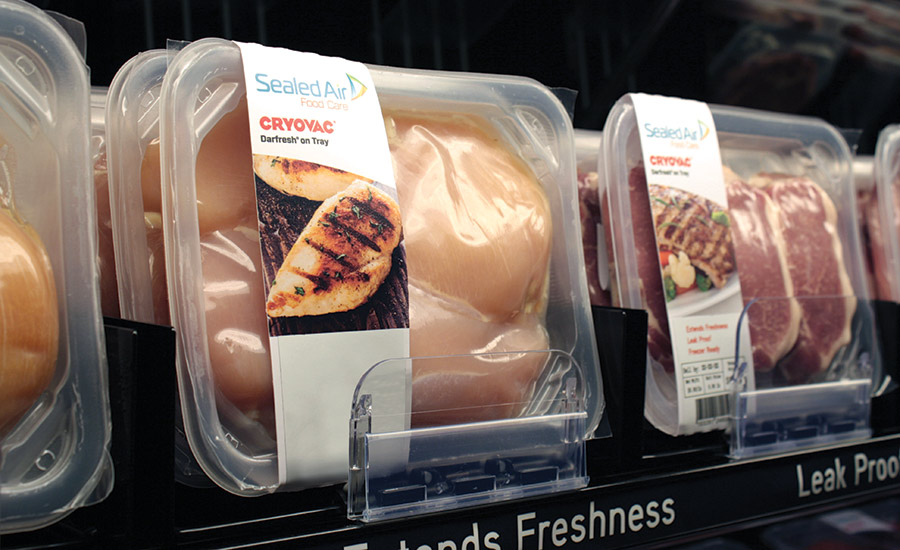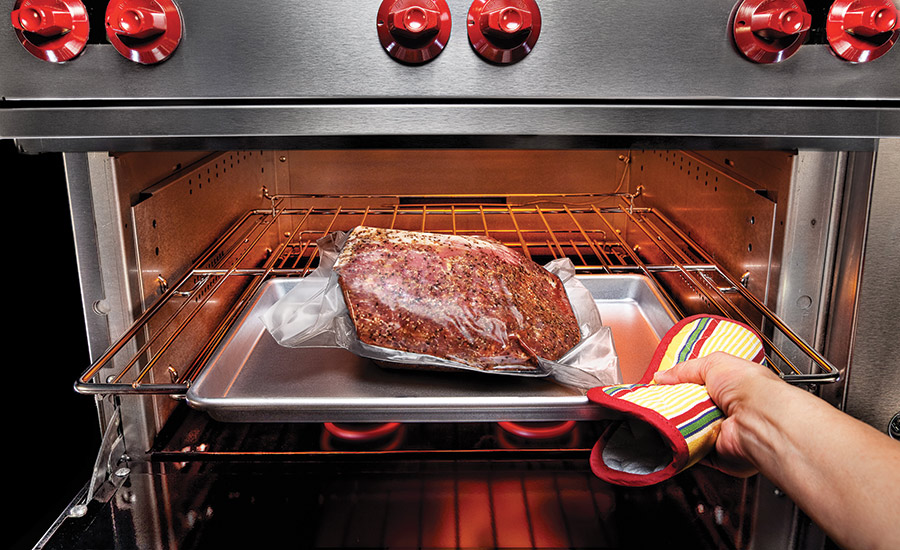New extended shelf life (ESL) and food waste prevention methods in fresh meat and seafood packaging have consumers craving more. This is noticeable by the global market’s strong rise over the last few years, thanks to increased shelf life of meat products, a growing demand for customization in meat films by meat producers and the benefits of flexible film packaging over rigid packaging.
A recent report by Technavio (technavio.com) reveals the fresh meat packaging market will reach a compound annual growth rate (CAGR) of over 3 percent to 2022. Case-ready fresh meat packaging has been growing globally since 2010. By using fresh meat case-ready packaging, retailers can reduce operating costs such as labor cost, meat-cutting equipment cost and space utilization cost for fresh meat preparation.
“Meat cutting and preparation in retail stores require a huge space, whereas case-ready fresh meat packaging can assist retailers in saving that space for other retail merchandising operations. Case-ready fresh meat packaging also prevents leakage and provides better quality control. All these benefits of case-ready fresh meat packaging are increasing the adoption of fresh meat packaging across the world,” says a senior analyst at Technavio.
MAP vs. VSP
Modified atmosphere packaging (MAP), also known as protective atmosphere packaging or reduced oxygen packaging, uses a mixture of pure oxygen, carbon dioxide and nitrogen, which is introduced into the packaging process. This type of packaging is typically used for red meat to make it “bloom” for eye-
appeal on shelf. However, with vacuum skin packaging’s (VSP) latest attributes—earlier detection of skin package leaks and early spoilage—more and more meat packagers, processors and retailers are turning.

Brian Conrad, marketing manager at Bemis North America (bemis.com) says: “Many of our customers are moving away from pre-made master pouches to our new cast coextruded films. These films allow the processor to use a flow wrapper to package multiple 1 lb. ground beef packages in a gas-flushed master pack and save money by using a flow wrap film instead of pre-made pouches.”
The barrier MAP packaging format also extends shelf life and reduces retail shrink due to markdowns or product spoilage.
Conrad adds that the move to fresh meat isn’t just in the retail channel. “Foodservice customers are looking for fresh too, as has been publicized with the move from frozen to fresh ground beef patties at a major restaurant chain.”
The Cryovac line by Sealed Air (sealedair.com) includes Darfresh on Tray, a vacuum-skin packaging solution for extended shelf life of case-ready meats as well as Grip & Tear vacuum packaging with an easy-open tab that eliminates the need for cutting tools. The Cryovac range was designed to help food processors improve operational efficiency, while ensuring food safety and reducing labor, food waste and cost.
Greg Levy, president of Point Five Packaging (p5pkg.com) says that skin packaged packs can be displayed vertically without spoiling the presentation of the product inside. Red meat products can have an increased shelf life of 14-21 days, while white fish can increase up to 8 days. For retailers, product can now remain in date over two consecutive weekends extending sales opportunities. Meats can be marinated in the tray, and it can mature in-pack improving tenderness, taste and texture. There is also tamper evidence with skin packaging, which reduces not only leaks but product returns to store.

Two other popular meat packaging solutions are shrink bags and shrink rollstock films. The Oven Ease bag is also part of Sealed Air’s Cryovac line. It combines the benefits of VSP with the convenience of oven-ready cooking. The bag is a flexible film that can be placed directly in a preheated oven and withstand temps up to 400 degrees Fahrenheit. The heavy duty and abuse-resistance materials are available in multiple gauges (2, 2.5 and 3 mils). The Oven Ease bag was designed for both consumer and food service applications.
According to Bemis, most meat processors are faced with high labor turnover and thus, in the current low unemployment economy, it’s difficult to retain and hire employees. “Our fresh pork processor customers are gravitating toward the Flow-Tite® shrink films in conjunction with flow wrap equipment, to replace pre-made shrink bags, to help mitigate some of the labor issues they are experiencing,” Bemis’s Conrad says.

Labels Get Smarter
Consumers want product information at the ready in order to make a purchase. The lack of understanding—and lack of communication—about sell-by, best-before and use-by dates can result in good food hitting the trashcan, especially foods that don’t normally have a long shelf life, such as meat and seafood. U.K. retailer Sainsbury implemented a color-change smart label for fresh meats in its deli case last summer, in order to give clear and simple real-time feedback on product quality. The time- and temperature-sensitive labels are the company’s effort to lessen product waste.
The Smart Fresh label acts as a reminder to consumers about deli meat freshness. Once they open a pack of ham and put it back in the fridge, the label changes color from yellow to purple, the longer the pack has been open. The rate of color change is designed to slow down depending on how cool the refrigerator is.

We spoke with Drew Lericos, marketing director at MULTIVAC (us.multivac.com), to find out the trends, benefits and expectations in fresh meat/seafood packaging lately. Packaging Strategies: What trends have you seen in meat/seafood packaging?Lericos: Trends are taking a turn lately, fueled by online shopping, ready meals and meal kits, which demand a new paradigm of packaging requirements including consumer convenience, material source reduction and extended shelf life. Today, packaging is built much more with the end-user in mind, making it easier to open and re-close, often with cook-in or reheat package features and more appropriately portion-sized. PS: How is current packaging answering the call for longer shelf life?DL: Advances in Oxygen Transition Rates (OTR) of lidding film impacts shelf life from seafood to red meat to poultry. Seafood lidding film now comes with micro-perforations that allow oxygen into the package. While this may seem counter-intuitive, it is actually a safety feature, allowing the user to detect spoilage when opening the package, prior to the time that harmful bacteria-producing toxins can grow. Vacuum skin packaging (VSP) pulls the top film onto the product and eliminates nearly all internal package atmosphere. For red meat products in modified atmosphere packaging (MAP), gas flushing helps stabilize the protein, while also allowing the meat to “bloom” for better visual appeal when exposed to oxygen once the package is opened. PS: And how about preventing food waste?DL: We are seeing protein portions packed in a single-serve VSP pouch and sold as a multi-pack. This is historically different from bulk packaging, where several portions were deposited into a single lidded tray. Now, the consumer can use only what is needed and conveniently store the remainder without opening the package to atmosphere. This helps extend shelf life and reduces food waste. PS: What are your customers looking for in meat/seafood packaging?DL: Vacuum skin packaging is garnering a lot of appeal in meat and seafood packaging. VSP is very popular in Europe for red meat processors, where the majority of packages have converted exclusively to skin pack. In the U.S. the fresh seafood industry has made a major move into VSP packaging, largely because of the shelf life, appearance and marketable attributes of the package. Recently, we have started to see the meat and poultry side move into VSP, beginning with more premium and specialty products. PS: How can the industry give consumers eye-catching product packaging, while also protecting the meat inside?DL: The absence of oxygen in a VSP package improves shelf life and results in reduced loss due to product spoilage. It is safer too, because if a skin package leaks it will be readily noticeable to the consumer prior to purchase. Even a small leak will result in an air pocket bubble around the product, if not complete delamination from the substrate. In this way, package leakers and therefore, early spoilage, are more easily detectable than non-skin pack MAP packaging has been in the past. VSP packaging allows consumers to see more of the product. Marketers can communicate important product attributes more creatively and effectively with new full wrap labeling on VSP packages. PS: Are there any new technologies that will further enhance these features?DL: MULTIVAC offers VSP variations with MultiFresh skin technologies and FormShrink. One variation of a MultiFresh package is the addition of a perimeter seal for added security. A FormShrink package is typically a cut of meat that is vacuum skin packed, but the film has fully surrounded the meat portion without a rigid bottom web or tray-type structure. |


